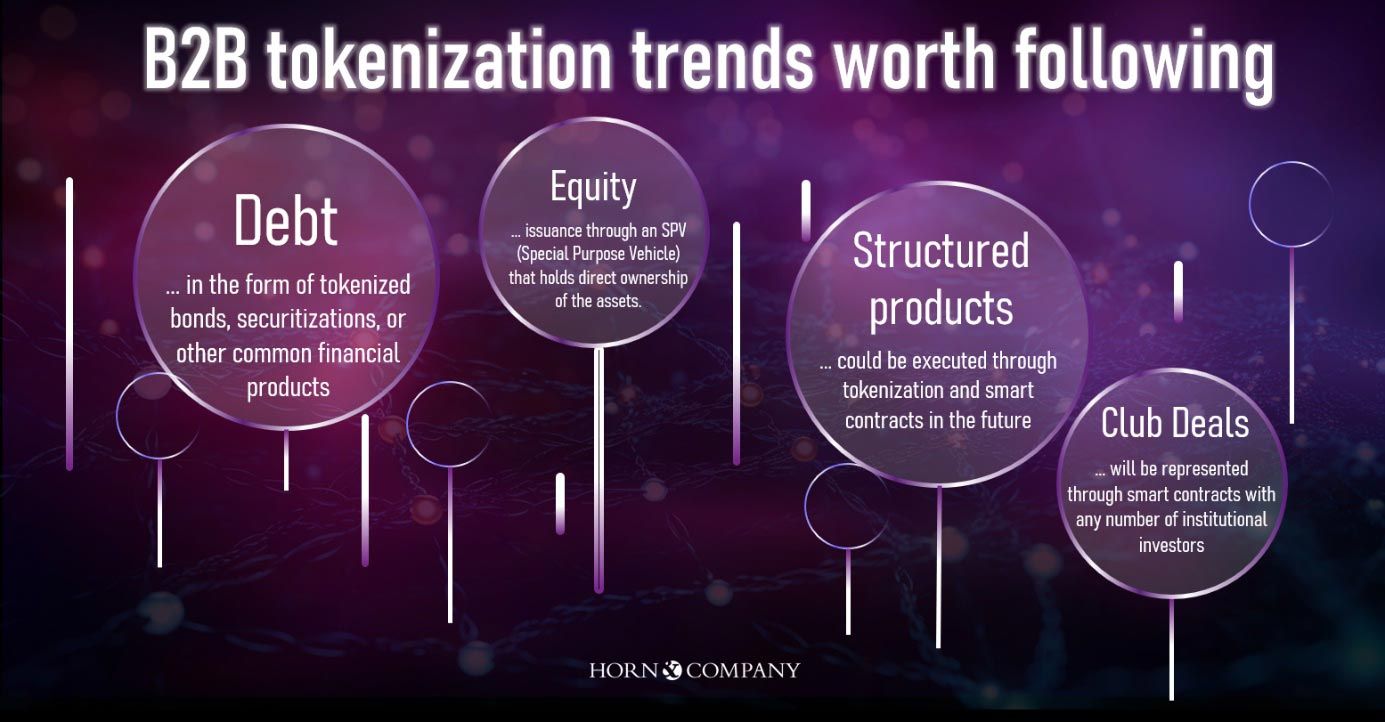
HOW TOKENIZATION OF ASSETS IS SHAPING THE FINANCIAL LANDSCAPE: A COMPREHENSIVE ANALYSIS
#HornAndCompany # Blockspace #DigitalAssets #Token #Crypto
The tokenization of assets is a term gaining increasing prominence in the financial realm. In this article, we will delve into the technology underpinning tokenization, exploring its challenges, risks, and future prospects. Furthermore, we’ll examine tokenization’s role in the global economy and its contribution to sustainability.
Deep Dive into the Technology of Tokenization – B2C
Tokenization is a process where physical assets are converted into digital tokens and stored on a blockchain.
To illustrate this with a practical example, imagine a property owner wishes to offer investors the opportunity to purchase shares in his property. He chooses to accomplish this via tokenization. Initially, the property’s value is assessed and divided into a predetermined number of shares or tokens. Each token represents a fraction of ownership in the property. These tokens are then stored on a blockchain using Smart Contracts – these are automated programs. The Smart Contracts define the terms of the tokens, including the rights of the token holders. Investors can now purchase these tokens and thereby invest in the property. Token holders can trade their tokens on secondary markets. This increases liquidity and makes the market more accessible overall, as it allows for smaller investment volumes.

Deep Dive into the Technology of Tokenization – B2B
Often, in the context of tokenization, discussions revolve around solutions intended ultimately for the private end consumer, whether in small amounts or in the high-end private banking sector. However, tokenization, especially for the much larger and broader sector of (semi-)professional actors, offers numerous application possibilities.
Debt Capital: In the near future, it will be possible to represent current financing solutions as digital assets. Today, we already see bonds and securitizations that exist in the digital space through tokenization, enjoying the associated benefits in terms of speed, cost, and risk. In just a few years, it’s probable that all essential financial products that we recognize today in the financial world will also be found as digital assets within the European region.
Equity Capital: Today, it’s not entirely straightforward to bring equity onto the blockchain. After many years of pioneering work, and with the participation of regulatory authorities, there are now some specialized providers that enable equity forms to be tokenized in a fully regulated and legally sound manner, then transferred to the blockchain. In structuring, such providers usually utilize so-called SPVs that hold direct ownership of the assets and, in return, issue equity instruments. Here, the flexible divisibility, implementation speed, and minimal marginal costs for additional investors come into play.
Structured Products: What occupies an entire industry of financial engineering today could be managed tomorrow by tokenization and smart contracts. The only limits here are set by the degree of creativity and the gradual adaptation by regulators. Whether it’s about simple “digital twins” of existing products, which can be traded much faster and theoretically in any divisibility, or about the desire for mixed structures, for example, various indices or a bundle of assets – all these solutions can be represented as tokens.
Financing Conglomerates and Club Deals: Especially for professional or institutional investors, tokenization opens up very elegant opportunities. An arbitrary number of institutional investors can participate in a project where all expected cash flows are already represented in the smart contract. Depending on the investors’ wishes, these structures can be designed completely transparently or not. Likewise, a secondary market is optional. If a liquid solution is preferred, the link to a secondary market can be established, and the tokens (in any divisibility) can be introduced to the market.
Challenges and Risks of Tokenization
Tokenization also presents challenges and risks. One of the primary issues is security. While blockchain technology itself is generally considered secure and has proven to be so in the past, the situation is different for platforms that provide wallets and infrastructure. They have repeatedly been vulnerable to hacking attempts and security breaches.
The widespread adoption of wallets, especially among institutional investors, currently remains a challenge. Specialized service providers offer solutions for this client segment, so the main effort here is to raise awareness about the feasibility.
Another concern is acceptance. Many traditional investors are still hesitant to invest in tokenized assets, often due to a lack of knowledge or distrust of the underlying technology. On the flip side, depending on the type of asset, there might be a limited supply of assets that can even be transferred to the blockchain.
Tokenization and Sustainability
Tokenization can play a crucial role in promoting sustainability. By tokenizing environmental projects or green bonds, more investors might be encouraged to invest in sustainable ventures. Additionally, the transparency provided by blockchain technology can ensure that companies and investors are better informed about the sustainability measures of the projects they’re investing in.
For instance, tokens linked to renewable energy projects can offer investors the chance to invest directly in clean energy. This, in turn, could expedite the development of renewable energies and contribute to achieving global sustainability goals.
Furthermore, tokenizing CO2 certificates could fundamentally make CO2 markets more efficient, simplifying and accelerating the measurement and reduction of CO2 overall.
Future Prospects of Tokenization and its Role in the Global Economy
Tokenization is anticipated to take on an increasingly central role in the global economy. By facilitating international trade and boosting liquidity, tokenization could lead to more efficient and better-connected global markets. Additionally, it promotes financial inclusion by offering individuals in underserved regions access to new investment and financing opportunities.
Looking towards the future, we might observe an expansion of tokenization to new asset classes such as intellectual property, personal data, or even individual skills. On an institutional level, we anticipate enhanced adoption in financing and structuring solutions. Here, the benefits of eliminating costly intermediaries are evident, and professional market players will seize these opportunities to enhance the profitability of products, consequently boosting their own profits. Ultimately, projects deemed not profitable enough today might be realized in the future if the setup costs are reduced.
Conclusion: Tokenization is here to stay
Tokenization is a potent tool with the potential to fundamentally reshape the financial world. By transforming assets into tradable tokens, it unlocks new possibilities for investments, liquidity, and global trading relations. The technology behind tokenization is captivating, offering a plethora of applications. Yet, the challenges and risks, especially in the realms of security and acceptance, need to be diligently addressed. A key aspect will be for the industry and regulatory authorities to collaborate closely, fostering an environment that encourages innovation while simultaneously ensuring investor security and interests.
Nevertheless, the technology, specialized providers, and the market for tokenized assets already exist today. Ultimately, for the finance industry, tokenization is not a question of “if” but “when”. Similar to past technological leaps, the query is about when the “tipping point”, i.e., the moment of rapid market penetration, will be achieved.
DO YOU HAVE SPECIFIC QUESTIONS ABOUT TOKENIZATION?
This blend of vast potential and challenges signifies an exciting era for banks, investors, issuers, and everyone at the intersection of finance and technology. The team at Horn & Company looks forward to assisting you on this journey.


